Martialia
Martialia hyadesi
Paul G. K. Rodhouse, Richard E. Young, and Michael VecchioneIntroduction
Martialia hyadesi was originally described from a single specimen in 1882 and redescribed in 1990 (Rodhouse and Yearman, 1990). By 1986, twenty thousand tons of M. hyadesi were taken as bycatch in the Illex argentinus fishery. M. hyadesi is a moderate-sized ommastrephid reaching a maximum size of at least 319 mm ML.
The specific name of M. hyadesi presumably reflects that of the ship's surgeon on Charcot's ship the POUQUOIS PAS whose name was Hyades and whose ability to cure mal de mer was revered.

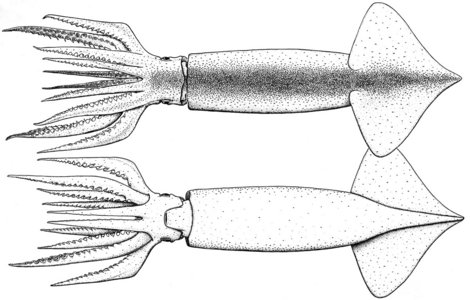
Figure. Dorsal and ventral views of M. hyadesi. Drawings from Rodhouse and Yeatman (1990).
The original description can be found here.
Brief diagnosis:
A member of the Todarodinae with ...
- tentacular club extending nearly to base of tentacle and not expanded.
- well developed trabeculae associated with reduced protective membranes on arms and tentacles.
Characteristics
- Arms
- Arms with poorly developed protective membranes but large and prominent trabeculae.
- Right arm IV hectocotylized; left arm IV slightly modified.
- Distal third of right arm IV with small suckers on long stalks; on ventral side, trabeculae form rounded flaps; on dorsal side trabeculae without free ends (free ends of trabeculae gradually diminish in size over proximal two thirds of arm until trabeculae present only as rounded bases to suckers).
- Suckers of distal third of left arm IV sometimes with elongated stalks.
- Tentacles
- Tentacles much like enlarged arms; most of tentacle occupied by club.
- Tentacular club not expanded (round in cross-section); not clearly differentiated into carpus, manus and dactylus.
- Protective membrane poorly developed; trabeculae strongly developed.
- Tentacular stalks with 3-5 free trabeculae proximal to first suckers on each margin.
- Tentacles much like enlarged arms; most of tentacle occupied by club.
- Head
- Beaks: Descriptions can be found here: Lower beak; upper beak.
- Beaks: Descriptions can be found here: Lower beak; upper beak.
Comments
More details of the description of M. hyadesi can be found here.
Ecology
Beaks and soft parts from the regurgitations and gut contents of wandering (Diomedea exulans), grey-headed (Diomedea chrysostoma) and black-browed (Diomedea melanophris) albatross chicks from Bird Island, South Georgia, indicate that M. hyadesi is an important component of the cephalopod diet of these birds and that it is ecologically important in the sub-Antarctic waters of the south Atlantic (Rodhouse, 1990).

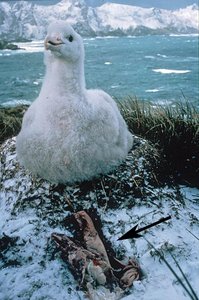
Figure. Wandering Albatross chick at Bird Island, South Georgia with some still
warm and steaming, part digested squid (probably Martialia) he has just chucked up (arrow). ©
Because of the abundance of M. hyadesi, commercial fishing trials have been carried out in the vicinity of South Georgia, and 8 tons of squid were caught at the Antarctic Polar Front (Rodhouse, 1990).
Distribution
Type locality: Cook Bay, Cape Horn. The holotype is in poor condition and deposited in the Museum Nationale d'Histoire Naturelle, Paris.
References
Rodhouse, P. G. and J. Yeatman. 1990. Redescription of Martialia hyadesi Rochebrune and Mabille, 1889 (Mollusca: Cephalopoda) from the Southern ocean.Bull. Br. Mus. nat. Hist (Zool.), 56(2): 135-143.
Roeleveld, M. A. 1988. Generic interrelationships within the Ommastrephidae (Cephalopoda). P.277-314. In: M. R. Clarke and E. R. Trueman (eds.). The Mollusca. Vol. 12. Paleontology and Neontology of Cephalopods. Academic Press, N.Y., 355pp.
Title Illustrations

| Scientific Name | Martialia hyadesi |
|---|---|
| Location | Deck of a Japanese jigger off the Falkland Islands |
| Specimen Condition | Fresh |
| View | Dorsal |
| Image Use |
 This media file is licensed under the Creative Commons Attribution-NonCommercial License - Version 3.0. This media file is licensed under the Creative Commons Attribution-NonCommercial License - Version 3.0.
|
| Copyright |
©

|
About This Page

University of Hawaii, Honolulu, HI, USA

National Museum of Natural History, Washington, D. C. , USA
Page copyright © 2008 , , and
 Page: Tree of Life
Martialia . Martialia hyadesi .
Authored by
Paul G. K. Rodhouse, Richard E. Young, and Michael Vecchione.
The TEXT of this page is licensed under the
Creative Commons Attribution-NonCommercial License - Version 3.0. Note that images and other media
featured on this page are each governed by their own license, and they may or may not be available
for reuse. Click on an image or a media link to access the media data window, which provides the
relevant licensing information. For the general terms and conditions of ToL material reuse and
redistribution, please see the Tree of Life Copyright
Policies.
Page: Tree of Life
Martialia . Martialia hyadesi .
Authored by
Paul G. K. Rodhouse, Richard E. Young, and Michael Vecchione.
The TEXT of this page is licensed under the
Creative Commons Attribution-NonCommercial License - Version 3.0. Note that images and other media
featured on this page are each governed by their own license, and they may or may not be available
for reuse. Click on an image or a media link to access the media data window, which provides the
relevant licensing information. For the general terms and conditions of ToL material reuse and
redistribution, please see the Tree of Life Copyright
Policies.
- First online 04 May 2008
- Content changed 04 May 2008
Citing this page:
Rodhouse, Paul G. K. , Richard E. Young, and Michael Vecchione. 2008. Martialia . Martialia hyadesi . Version 04 May 2008. http://tolweb.org/Martialia_hyadesi/19936/2008.05.04 in The Tree of Life Web Project, http://tolweb.org/






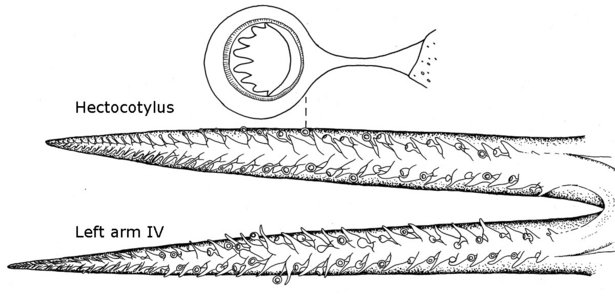

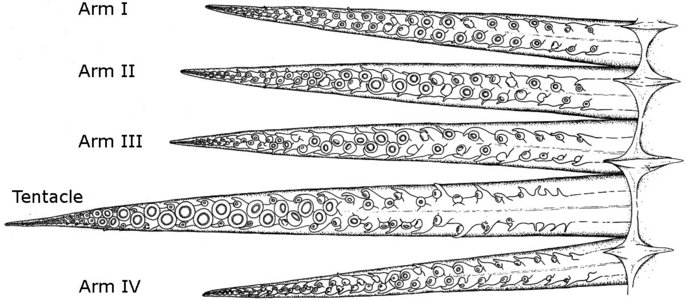
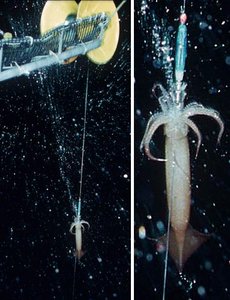
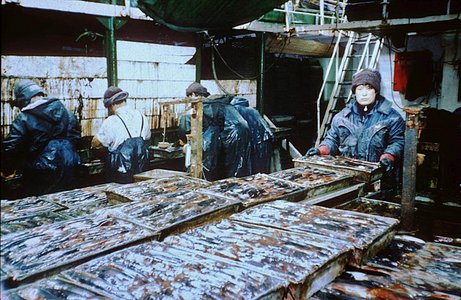



 Go to quick links
Go to quick search
Go to navigation for this section of the ToL site
Go to detailed links for the ToL site
Go to quick links
Go to quick search
Go to navigation for this section of the ToL site
Go to detailed links for the ToL site